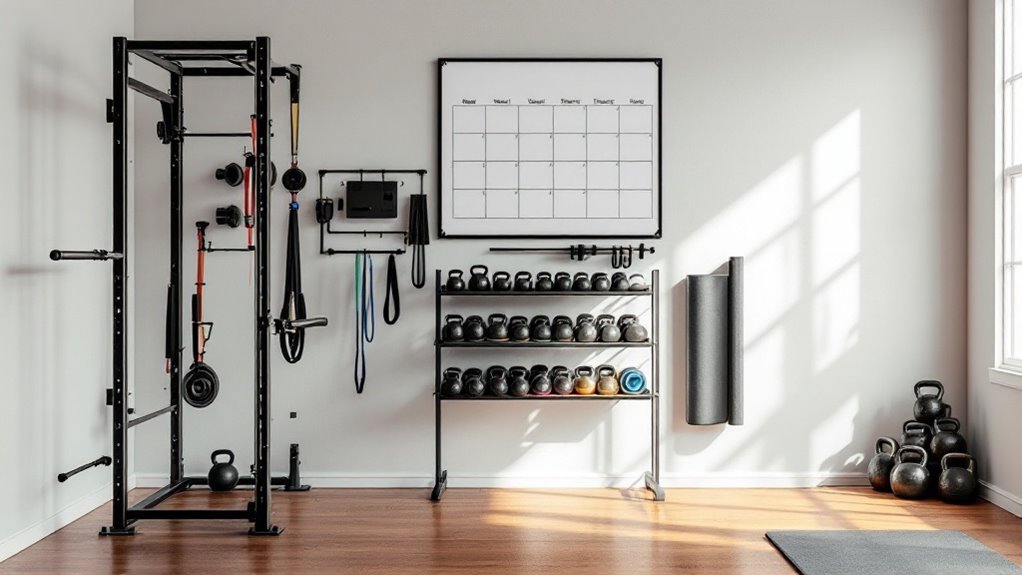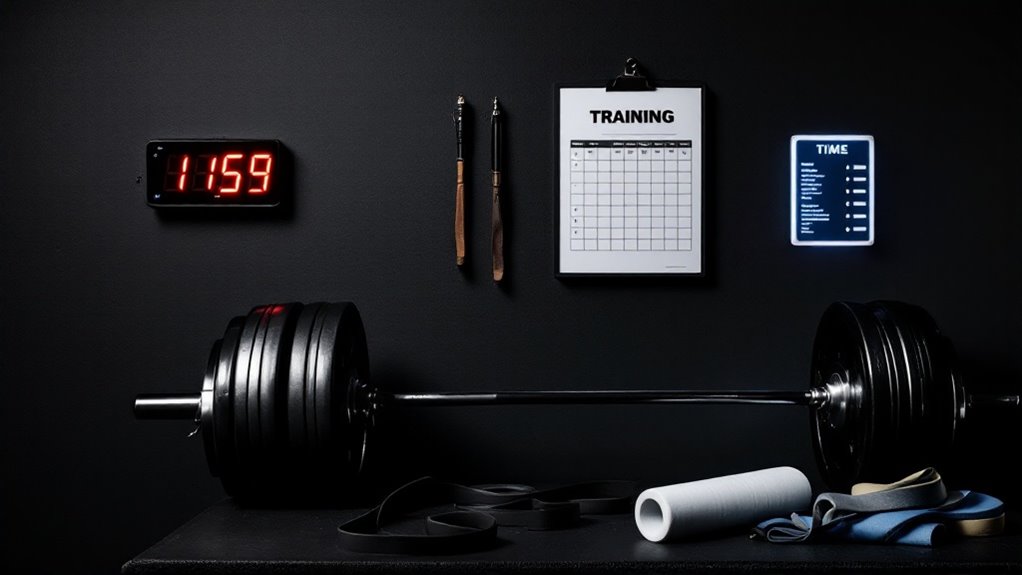Build a Workout Plan

Building an effective workout plan starts with establishing clear, measurable fitness goals. The plan should incorporate compound exercises coordinated with individual capabilities and schedule constraints. Training splits must follow specific guidelines for sets, reps, and rest periods based on goals – whether strength, hypertrophy, endurance, or power. Consistent progress tracking through detailed workout logs enables necessary adjustments. A well-structured plan transforms aspirations into achievable milestones that yield remarkable results.
Key Takeaways
- Start by establishing specific, measurable fitness goals that align with your desired outcomes and available time commitment.
- Select exercises that match your fitness level, incorporating compound movements for maximum efficiency and available equipment accessibility.
- Structure your weekly training splits based on your schedule, ensuring adequate rest between muscle groups and recovery time.
- Program your sets, reps, and rest periods according to your goals – strength, hypertrophy, endurance, or power.
- Track your workouts consistently and measure progress monthly to make necessary adjustments for continuous improvement.
Setting Clear Fitness Goals and Priorities

Before commencing on any fitness journey, establishing clear and specific goals serves as the foundation for long-term success.
Setting defined fitness goals isn't just planning – it's laying the groundwork that enables lasting transformation and achievement.
Like a military mission, fitness objectives must be precise, measurable, and time-bound.
Whether targeting weight loss, muscle gain, or improved endurance, individuals should write down their primary goals and break them into smaller, achievable milestones. This creates a strategic roadmap for progress tracking.
Prioritizing these goals means coordinating workouts with desired outcomes.
Someone focused on strength might emphasize resistance training, while an endurance athlete would prioritize cardiovascular work.
Success comes from maintaining laser focus on these established priorities.
Remember to approach your goals with self-compassion and patience as you develop sustainable habits for lasting results.
Selecting the Right Exercises and Training Split

Once clear goals have been established, selecting appropriate exercises and organizing them into an effective training split becomes the critical next phase of building a successful workout plan.
The selection process requires careful consideration of movement patterns, equipment availability, and individual capabilities. A well-designed training split optimizes recovery while maintaining consistent progress toward fitness goals.
- Compound exercises form the foundation of effective workouts, targeting multiple muscle groups simultaneously.
- Training splits should correspond with weekly schedule and recovery capacity.
- Exercise selection must match current fitness level and available equipment.
- Progressive overload principles guide exercise progression and intensity management.
A proper warm-up routine helps prepare muscles and joints for the upcoming workout while reducing injury risk.
Understanding these fundamental components enables the creation of a sustainable and results-driven workout structure that supports long-term success.
Programming Sets, Reps, and Rest Periods

Programming sets, repetitions, and rest periods represents the precise architecture of any successful workout routine. The strategic combination of these elements determines workout intensity, endurance development, and recovery enhancement. By following established guidelines for different fitness goals, exercisers can optimize their training effectiveness.
| Goal Type | Sets | Reps | Rest Period |
|---|---|---|---|
| Strength | 3-5 | 4-6 | 2-3 min |
| Hypertrophy | 3-4 | 8-12 | 60-90 sec |
| Endurance | 2-3 | 15-20 | 30-45 sec |
| Power | 3-5 | 1-5 | 3-5 min |
Proper programming guarantees progressive overload while preventing overtraining, enabling consistent improvement in physical performance and body composition. Regular monitoring of proper form technique during fundamental exercises like squats and deadlifts ensures safe and effective strength development.
Tracking Progress and Making Adjustments

Regular tracking and adjustment of workout performance serves as the compass that guides continuous fitness progress.
Maintaining detailed records of exercises, weights, repetitions, and perceived exertion enables informed decisions about program modifications. This systematic approach allows individuals to identify plateaus, celebrate victories, and make evidence-based adjustments to their training protocols.
- Document key metrics including weight lifted, sets completed, rest periods, and energy levels
- Take progress photos and body measurements every 4-6 weeks
- Monitor workout quality through rate of perceived exertion (RPE) scores
- Review training logs monthly to identify patterns and necessary program modifications
Following a linear progression model helps beginners consistently add weight to exercises while maintaining proper form.
Frequently Asked Questions
Should I Work Out if I'm Feeling Sick or Have a Cold?
Working out while sick depends on the location of symptoms and severity.
Above-the-neck symptoms like mild colds or stuffy noses typically allow for light exercise.
However, below-the-neck issues like chest congestion, body aches, or fever require rest to avoid worsening the condition and prolonging recovery.
Listen to your body – if symptoms worsen during activity, stop immediately and rest until fully recovered.
What Should I Eat Before and After My Workouts?
Like a race car needs premium fuel before hitting the track and maintenance after crossing the finish line, proper workout nutrition follows the same principle.
Pre-workout, consume complex carbs and lean protein 2-3 hours before exercising – foods like oatmeal with banana or whole grain toast with eggs.
Post-workout, within 30 minutes, have protein and fast-digesting carbs – protein shake with fruit or chicken with rice.
Is It Normal to Feel Dizzy or Nauseous During Intense Workouts?
Feeling dizzy or nauseous during intense workouts is common, especially when pushing physical limits.
These symptoms often result from reduced blood flow to the brain, dehydration, low blood sugar, or overexertion.
However, athletes should monitor these sensations carefully.
If symptoms persist or become severe, it's essential to stop exercising, rest, hydrate, and consult a healthcare provider to guarantee safe training practices.
How Long Should I Wait Between Different Muscle Group Workouts?
While beginners might enthusiastically jump from chest to legs in the same day, experienced athletes know proper rest is essential.
Muscles typically need 48-72 hours to recover fully between workouts. This recovery window allows for muscle repair, reduces injury risk, and optimizes growth.
Upper body can be trained while lower body recovers, enabling an efficient push-pull-legs split routine throughout the week.
When Is the Best Time of Day to Exercise for Optimal Results?
Research shows the ideal exercise time varies by individual goals and schedule.
Morning workouts boost metabolism and consistency due to fewer interruptions. Evening sessions can enhance strength and performance as body temperature peaks.
The key factor isn't the specific hour but rather selecting a time that allows sustained commitment. Hormonal fluctuations throughout the day affect exercise results differently for each person.
Final Thoughts
Building an effective workout plan requires careful attention to goals, exercise selection, and programming details. As luck would have it, these elements naturally correspond with human biology and psychology, making success achievable for anyone willing to commit. Through consistent tracking and strategic adjustments, what begins as a simple fitness plan often transforms into a life-changing journey of strength and self-discovery. The path to fitness excellence awaits those ready to take the first step.


